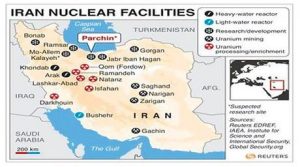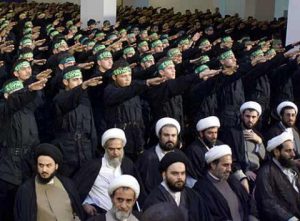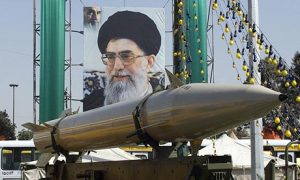
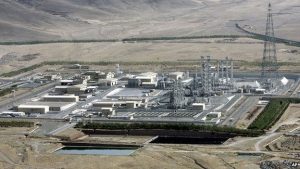
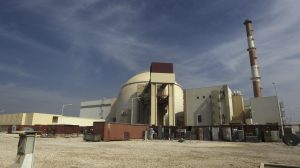
Raymond Tanter
20 JUNE 2017,
Nuclear Deal, Iran’s Missiles, & U.S. Sanctions
Breaking News
On June 18, Iran’s Revolutionary Guard Corps (IRGC) launched several midrange missiles from western Iran across Iraq and hit sources in Syria of Islamic State (ISIS) attacks on Tehran on June 7. In the context of these strikes, consider revelations about Iran’s missile sites on June 20 by the National Council of Resistance of Iran (NCRI) office in the United States (The People’s Mujahedeen Organization of Iran, PMOI aka Mujahedeen-e-Khalq MEK is the largest unit in the NCRI.)
Nuclear negotiations between Iran and the major powers began during 2013 and culminated in the Joint Comprehensive Plan of Action (JCPOA) in 2015. Thereafter, the IRGC intensified its activities to develop and expand Tehran’s missile program based on orders of the regime’s Supreme Leader, Ayatollah Ali Khamenei, per the NCRI revelations on June 20.
Evidence:
The NCRI verified locations of over three dozen centers involved in the production, testing, and launching of missiles by the IRGC. A dozen of these sites were exposed for the first time. The NCRI identified 42 IRGC missile centers involved in production, testing, storage, launch, and command. There are 15 that are part of Tehran’s missile manufacturing network.
The centers for building and testing missiles are in Iran’s central regions. Sites for medium-range ballistic missile launches are mostly in Iran’s western mountain regions, and central regions. In the southern provinces, missile launch centers are aimed at the Persian Gulf and Gulf of Oman. The location of these centers across Iran suggests IRGC missile objectives are oriented toward Iran’s western and southern borders.
The Nuclear Deal and U.S. Sanctions
The nuclear accord imposes few restrictions on Iran regarding ballistic missiles and does not prohibit new sanctions from being levied on Iran. UNSCR 2231, which gave international legal authority to the nuclear deal, “called upon (Iran) not to undertake any activity related to ballistic missiles designed to be capable of delivering nuclear weapons,” but Tehran vowed to ignore the Resolution. UNSCR 2231 does not prohibit new sanctions from being imposed on Iran, providing an occasion for President Trump to review the nuclear deal. The President told Secretary Tillerson on Apr. 19 to announce Iran is in compliance with the accord but also said the National Security Council (NSC) had 90 days to finish the review, which is coming up in July.
Meanwhile, on June 15, The Senate voted 98-2 in favor of a bill to impose new U.S. sanctions to target Iran’s ballistic missile program, its support for terrorism, and human rights violations.
The Way Forward
First, one outcome of the NSC review should be that the nuclear deal be modified to include ballistic missile research, development, and testing by Tehran. Trump should order the NSC to consider the testimony during passage of the June sanctions bill to justify pressing Iran to accept new restraints on its missiles. And the President should insist the NSC and State include evidence proffered by the NCRI on June 20 to justify revisions of the accord.
Second, the review should mention the NCRI as having provided valid evidence on prior violations by the Iranian regime regarding nuclear sites, testing of trigger mechanisms for nuclear weapons, and the most recent revelations on June 20 concerning ballistic missiles. The NCRI office on Pennsylvania Ave is a stone’s throw from the White House. If its delegation met with the President in the Oval Office and briefed his NSC staff in the Situation Room, it would indicate the tide is turning even further against Tehran. Such sessions with the main opposition to Tehran would place pressure on Iran to renegotiate the nuclear deal.
Third, if President Trump tweets about the Iran Freedom Rally on July 1 in Paris, he will see policies espoused there don’t require compromising on his policy of putting “America first.”
A bipartisan group of present and former legislators have attended or plan to attend the rally. Even more noteworthy, on Apr. 14, Senate Armed Services Committee Chairman John McCain (R-Ariz.), visited Albania to meet with NCRI officials, including its president-elect, Maryam Rajavi.
There is support across the aisle in Congress to back the NCRI. It has received about three decades of bipartisan congressional support. See H.Con.Res.159– introduced in Nov. 2016 by Homeland Security Committee Chairman Michael McCaul (R-Texas), Foreign Affairs Committee Chairman Ed Royce (R-Calif.) and ranking member Elliot Engel (D-N.Y.), as well as Rep. James McGovern (D-Mass.).
Although it is standard operating procedure for American Embassy officials to accompany congressional delegations (CODELS), it is remarkable that the Deputy Chief of the U.S. Mission and many of our Embassy staff in Tirana were in the presence of NCRI officials. It is hard to conceive of that situation occurring in the Obama-Kerry era!
Raymond Tanter :
Prof. Raymond Tanter (@AmericanCHR) served as a senior member on the Middle East Desk of the National Security Council staff in the Reagan-Bush administration, Personal Representative of the Secretary of Defense to international security and arms control talks in Europe, and is now Professor Emeritus at the University of Michigan. Tanter is on the comprehensive list of conservative writers and columnists who appear in The Wall Street Journal, Townhall.com, National Review, The Weekly Standard, Human Events, The American Spectator, and now in Newsmax.
